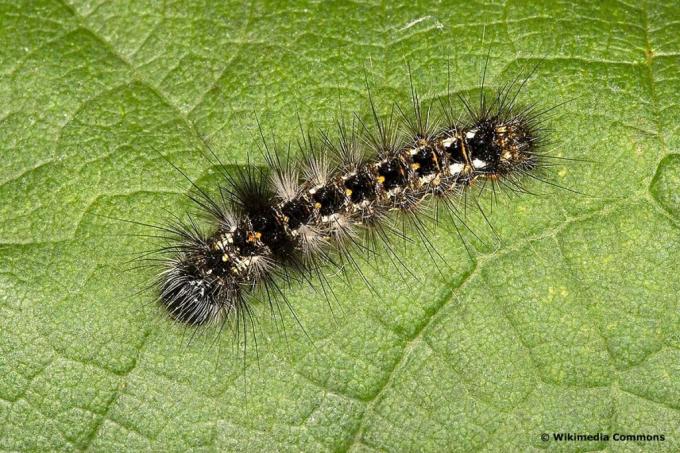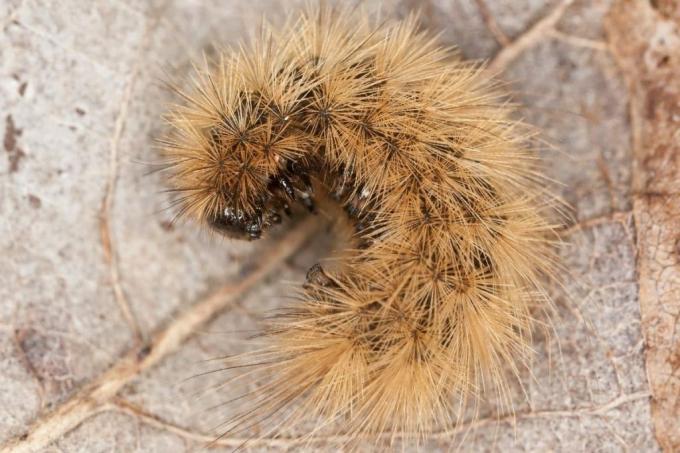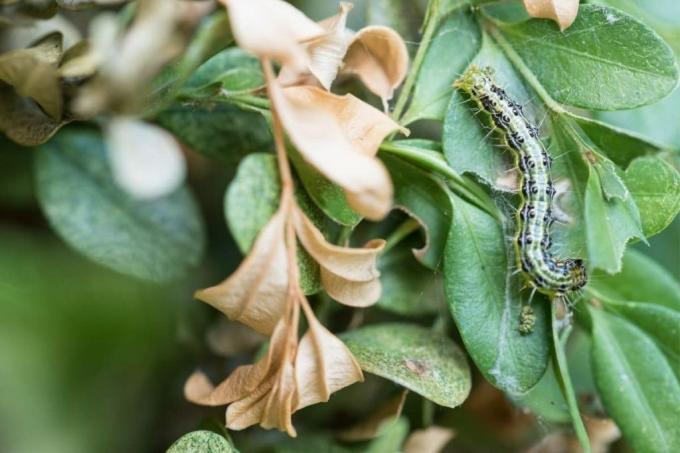
table of contents
- Moth
- Butterflies
- frequently asked Questions
Unfortunately, summer time is also caterpillar time. However, this pest is not limited to the summer months, because some caterpillars can already taste your plants in April.
In a nutshell
- Caterpillars in April target buds and young leaves
- natural enemies help with many caterpillars
- However, baldness is rather the exception
Moth
Blackberry Moth (Macrothylacia rubi)

- Caterpillar season: from August, after wintering until April
- Size: up to 80 millimeters
- Color / appearance: black with yellow or orange incisions, black and red-brown hair, light gray hair on the sides
- Affected plants: Shrubs and herbaceous plants such as sloe, raspberry, blackberry, yellow sun rose, gorse, small meadow head, clover, Sweet peas, ribwort
- Damage: leaf damage
- Combat: collect with gloves
Note: The caterpillars are nocturnal. The stinging hairs can cause allergies and skin reactions (caterpillar hair dermatitis).
Owl butterfly (Noctuidae)

- Caterpillar season: April to October
- Size: up to 60 millimeters
- Color / appearance: depending on the type, light (brown), black and white, green, e.g. T. with stinging hair
- affected plants: herbaceous plants, deciduous trees, shrubs
- Damage: feeding on root necks, leaf damage
- Combat: sugared bran porridge as bait, collect, spray with tansy tea, settlement of natural predators (e. E.g. caterpillar flies, parasitic wasps, common toad, blackbird, hedgehog, bats)
Note: Most of the caterpillars of the owl butterfly hide during the day because they are dusk or dawn. are nocturnal.
Great frostworm (Erannis defoliaria)

- Caterpillar season: April to June
- Size: up to 25 millimeters
- Color / appearance: brown-red, dashed sulfur yellow and red-brown on the belly
- Affected plants: preferably birch, beech, oak, hornbeam, linden, elm
- Damage: damage to fruit buds, leaf damage
- Combat: green glue rings (end of September to December) to intercept the females and take eggs, colonize predators (parasitic wasps, caterpillar flies). Spiders, ground beetles, songbirds, woodpeckers)
Note: If the caterpillars feel disturbed, they lower themselves to the ground with a spider thread. When the danger is over, they climb back up on the thread.
Little Frostworm (Operophtera brumata)

- Caterpillar season: March to June
- Size: up to 25 millimeters
- Color / appearance: green, weak web in buds and between young leaves
- Plants affected: fruit and deciduous trees, including oak, beech, hornbeam, maple
- Damage: feeding on buds and young leaves
- Combat: green glue rings (late September to December) to intercept the females and take eggs, colonize predators (parasitic wasps, caterpillar flies, spiders, songbirds)
Cinnamon bear (rust-winged bear, Phragmatobia fuliginosa)

- Caterpillar season: September to April
- Size: up to 35 millimeters
- Color / appearance: black-gray with dense tufts of red-brown or light-gray-brown hair, light yellow longitudinal stripes on the back
- Affected plants: herbaceous plants and shrubs, such as blackberries, blackthorn, meadowsweet, dandelion, ribwort, Jacob's hawkweed
- Damage: feeding on buds and young leaves
- Combat: hardly any predators (inedible), collect the caterpillars
Note: The caterpillars of this butterfly are inedible even for birds.
Butterflies
Box tree moth (Cydalima perspectalis)

- Caterpillar season: March to September
- Size: up to 50 millimeters
- Color / appearance: yellow-green to dark green with black and white stripes, black points and head capsule, white bristles
- affected plants: boxwood
- Damage: devastation until the plants die
- Combat: Neem oil preparations. Settlement of predators (tits, redstart, starlings, wasps)
Note: The box tree moth is an invasive species. Therefore, you should burn heavily infested plants.
Big fox (Aglais polychloros)

- Caterpillar season: April
- Size: up to 45 millimeters
- Color / appearance: dark gray to black with orange bands on the back and sides; orange, branched thorn outgrowths
- Affected plants: white willow, aspen, pear, cherry
- Damage: leaf damage
- Combat: cut off infected branches and expose caterpillars to willow or wild cherry in the wild (endangered butterfly species)
Note: The caterpillars of this butterfly like to eat in a sociable group from April onwards.
frequently asked Questions
Glue rings help against frost tension, as the females climb up the tree trunk to lay eggs. If they stick, they lay their eggs on the ring. Therefore, it is important that you remove the eggs before the larvae hatch.
Whether you “have to” control caterpillars depends on the severity of the infestation. The temperature plays a subordinate role, as flight and egg-laying are usually only delayed at cool temperatures.

